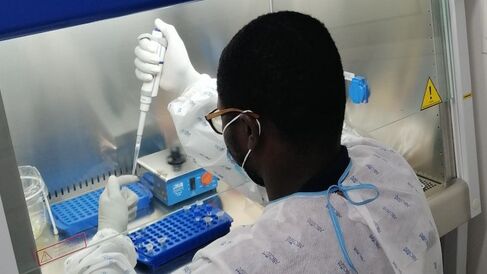Training

Novel SARS-CoV-2 diagnostic assay reagents were developed by UCAM as part of the AfriDx project. Below you can find links to training materials to develop and manufacture your own Boon-Enzymes for direct immobilisation on silica.
SOPs for all AfriDx biological reagents also been collated into a single page for those with existing experience in protein expression and purification.
AfriDx Training Objectives
- to build capacity for future design and development of diagnostics for disease outbreaks
- to build capacity for the biological tools and reagents used in AfriDx and AfriMx to be manufactured locally in LMICs.
- to enable local adaption of AfriDx to relevant future viral diseases.
- to strengthen local pathways for progression along the diagnostics value chain from trial to approval, manufacturing and distribution.
Module: Development of Boon-Enzymes
Download the Development of Boon-Enzymes Handbook >>
This module will cover the general protocols utilised for the development of novel BoonEnzymes. Protocols for polymerase chain reaction, gel extraction, klenow assembly, and preliminary expression will be provided, in addition to tips for E. coli transformations.
The Boon-Enzymes are heterogenous recombinant proteins that has been specifically designed to immobilise onto silica (component: R5 silaffin-tag), provide visual indication of protein expression and allow for protein tracking (component: mCherry), and either amplify targeted DNA/RNA (component: Bst DNA polymerase, reverse transcriptase X) or specifically bind to antigen targets (component: single-chain variable fragment (scFv)). The silaffin-tag will immobilise onto silica by simply incubating the two together in phosphatebuffered saline (PBS) under basic conditions and room temperature. The mCherry gives the protein a pink colour that can be seen without any specialty equipment but can be tracked in spectrophotometers with an excitation of 587 nm and an emission of 607 nm. Finally, the enzymes/scFv are active under standard LAMP/PCR or lateral flow test/ELISA conditions and can be utilised without further adjustments.
Those wanting to develop novel Boon-Enzymes can retain the existing affinity-tag fluorescent protein core and swap out the enzyme for further applications.
Module: Manufacturing Engineered Boon2-BST
Download the Boon2-Bst Manufacturing Handbook >>
This module will cover both the expression and purification protocol for the Engineered Boon2-BST. Boon2-BST is a heterogenous recombinant protein that has been specifically designed to immobilise onto silica (component: Δ3R5 silaffin-tag), provide visual indication of protein expression and allow for protein tracking (component: mCherry), and amplify targeted DNA using loop-mediated isothermal amplification by Bst DNA Polymerase.
Two methods are presented for protein expression (autoinduction and standard IPTG) to allow the user to utilise the protocol that best fits into their environment. The purification protocol aims to allow the user to purify the protein using silica immobilisation.
Expression Protocol for the Engineered Boon2-BST
- SOP 1: Protein Expression of Engineered Boon2-Bst
- SOP 2:Autoinduction Expression of Engineered Boon2-Bst
Please allow social and marketing cookies to show embedded content.
Purification Protocol for the Engineered Boon2-BST
Please allow social and marketing cookies to show embedded content.
These training materials were produced by Dr Dushanth Seevaratnam in the Cambridge Analytical Biotechnology group led by Prof Lisa Hall at the Department of Chemical Engineering and Biotechnology, University of Cambridge.
